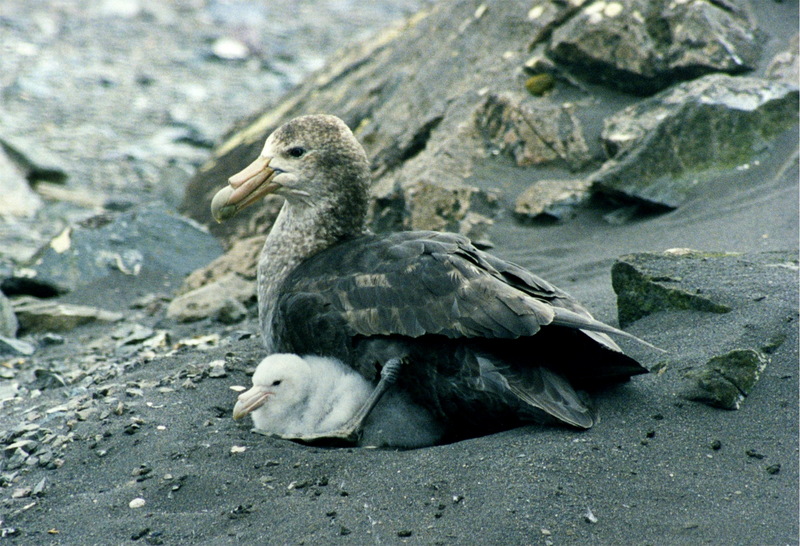| 새로운 사진 | 신문속의 동물소식 | 신기한 동물이야기 | 동물의 소리 | 동물동화상 | 사진 올리기 | 사진 저작권 | English |
|---|
| 재미있는 동물사진 | 괴수/괴어/엽기 동물사진 | 동물이름사전 | 동물목록 | 바깥고리 | 창고입구 | 똑똑누리집 |
|---|
| 이미지 정보 | Original File Name: Cutout_2-Southern Giant Petrel (Macronectes giganteus).jpg Resolution: 1536x1049 File Size: 729833 Bytes Date: 2007:12:12 10:48:39 Upload Time: 2007:12:12 10:49:46 | |
| 올린이 | 이름 (메일주소): Unknown | |
| 사진 제목 | Giant Petrel (Genus: Macronectes) - Wiki | |
 |
| Email : 카드 | 올린이 | 운영자 사진삭제 정보수정 Admin |
| 설명 | Giant Petrel (Genus: Macronectes) - Wiki
Giant petrel
The giant petrels are two large seabirds from the genus Macronectes. Long considered to be conspecific (they were not established as separate species until 1966), the two species, the Southern Giant Petrel (M. giganteus) and Northern Giant Petrel (M. halli) are the largest members of the petrel family, Procellariidae, and considered, with the two fulmars to form a distinct sub-group within the petrels. Both species are restricted to the southern hemisphere, and though the ranges overlap greatly, notably in South Georgia, the Southern Giant Petrel nests further south, with colonies on Antarctica. Giant petrels are aggressive predators and scavengers, which has led to the other common name they were known as, the Stinker. Giant petrels earn their name, being 86 cm (34 in) long and weighing 4.5 kg (10 lbs). They superficially resemble the albatross, and are the only procellarids with a comparable wingspan, around 195 cm (77 in). They can be separated from the albatrosses by their bill; the two tube nostrils are joined together on the top of the bill, unlike on albatross where they are separated and on the side of the bill. They are also much darker and more mottled brown (except for the white morph Southern, which are whiter than any albatross) and have a more hunch-backed look. They are harder to tell from each other, possessing similar long pale orange bills and uniform mottled grey plumage (except for 15% of Southern Petrels, which are almost completely white). The billtip of halli is reddish-pink and that of giganteus is pale green, appearing slightly darker and lighter than the rest of the bill, respectively. Also, the underside of older halli is paler and more uniform than giganteus, the latter showing a contrast between paler head and neck and darker belly. Classic examples of Northern Giant are identifiable at some range. Unfortunately young birds of both species are all dark and very hard to distinguish unless bill tip colour can be seen. Some relatively young Northern Giant Petrels can appear to be paler on the head suggesting Southern Giant and thus this species is harder to confirm. Giant petrels are highly opportunistic feeders, uniquely for procellarids they will feed on land as well as at sea, in fact they find most of their food near the coast. On land they feed on carrion, particularly that of seals and penguins. With that ability they are also the only petrel capable of walking well, they also display their dominance over carcasses with a "sealmaster posture": the head and the wings are held outstretched, the head pointing at the opponent and the wingtips pointing slightly back; the tail is raised to a vertical position. They are also capable of killing other seabirds, even those as large as an albatross, which they kill either by battering them to death (most commonly chicks of other species during the breeding season) or drowning. At sea they feed on krill, squid and fish, often attending fishing fleets in the hope of picking up offal. The Southern Giant Petrel is more likely to form loose colonies than the Northern, both species laying a single egg in a rough nest built up off the ground (about 50cm high). The egg is incubated for about 60 days, once hatched the chick is brooded for 3 weeks. Chicks fledge after about 4 months, but do not achieve sexual maturity for another 6-7 years after fledging. Southern Giant Petrels are listed as endangered on the Australian Environment Protection and Biodiversity Conservation Act 1999, while the Northern Giant Petrel is listed on this same Act as vulnerable. Their conservation status also varies from state to state within Australia. For example: Both the Southern and Northern Giant Petrels are listed as threatened on the Victorian Flora and Fauna Guarantee Act (1988). Under this Act, Action Statements for the recovery and future management of these species have been prepared. On the 2007 advisory list of threatened vertebrate fauna in Victoria, the Southern Giant Petrel is listed as vulnerable, while the Northern Giant Petrel is listed as near threatened. http://en.wikipedia.org/wiki/Giant_petrel
| |||
| 저작권 정보 | 사진의 저작권은 원저작자에게 있습니다. 동물그림창고는 동물관련 사진을 전시할 수 있는 공간만을 제공합니다.사진을 사용하고자 할 경우에는 저작권자와 협의하시기 바랍니다. |
|
|
|
| |||||||
| CopyLeft © since 1995, 동물그림창고. All rights may be reserved. | ||||||||
Stats